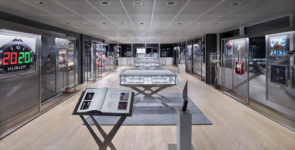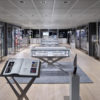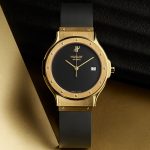
Hublot, for the few who still don't know, was not born as a brand (that is MDM Genève of the Italian entrepreneur Carlo Crocco, who moved to Switzerland in 1976) but as the name of the first luxury watch with a rubber strap, combined with a gold case. A true fusion of materials that were apparently unrelated to each other for the period (we are in 1980), where the strap had taken no less than four years of study to develop, until a solution was reached involving the insertion of some metal plates 'drowned' in the rubber to reinforce the point of attachment to the lugs by means of four screws and to make the strap integrated into the case. Moreover, the watch is equipped with a quartz movement rather than a mechanical one as one might imagine. The first design, with its unmistakable porthole-shaped case closed by a lid, naturally of marine inspiration, is replaced by the definitive design: with its side machining and the highly original rough-hewn case that creates a protrusion, it shows, surrounded by a bezel garnished with twelve visible screws (which are in fact the hour markers), a black case with no indication of anything except the brand name, the hands and the date.
It was all these characteristics that later won the favour of the sovereigns of Europe, first and foremost King Juan Carlos of Spain, and earned him the nickname 'Watch of Kings'. In 2004, the turning point: Jean-Claude Biver, a visionary and genius, joined Cracco at the helm of the company and created the concept of the art of fusing materials, carrying forward and further developing what had been the original principle of the Hublot watch, which had now become a brand. A year later, the Big Bang was born, a model that modified the traditional line known up to that point, incorporating some decidedly innovative concepts: the finally important dimensions of the case, which went from 36 to 45 millimetres; the greater prominence of technical elements, such as the screws on the bezel and lugs; the decision to abandon the elegant style at all costs, and move towards a more sporty direction.
Entry into the LVMH Group in 2008 allowed the brand to develop its production capacities. 2009 saw the inauguration of the Nyon Manufacture, just outside Geneva, where the following year saw the creation of the Unico, the brand's first entirely in-house movement, a column-wheel flyback chronograph. The creation of the Unico, which replaces the ETA movements previously used for chronographs, is the first step in Hublot's new course of manufacturing integration towards autonomy and leads to the creation of a department dedicated to grand complications. 2010 saw the birth of the heir to the 1980 model, officially launched under the name Classic Fusion, made of different materials, complications and special editions linked to prestigious partnerships. In 2015, a second production site was inaugurated, next to the original one: after only six years, the manufacture grew from 80 employees to no less than 300, with a new 8,000 square metre space alongside the 6,000 of the first.
Finally, in 2020, Hublot reinvents the 1980 Classic Original, a mechanical men's timepiece that combines both modern and classic materials, finishes and technologies and is offered in three different collector's models as a tribute to the brand's 40th anniversary. For more details click here.





